Soil for aquarium plants: types, selection and application
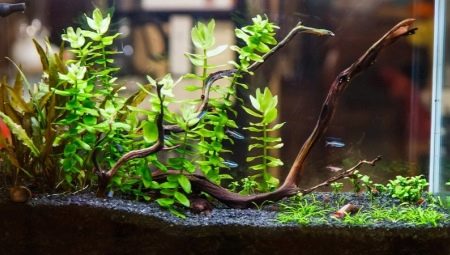
Aquarium soil is a key element in the arrangement of the tank. With its help, the interior design becomes aesthetically attractive, any ecosystem depends on its choice. The material in this article will tell readers what kind of soil is for an aquarium, how to choose and use it correctly.
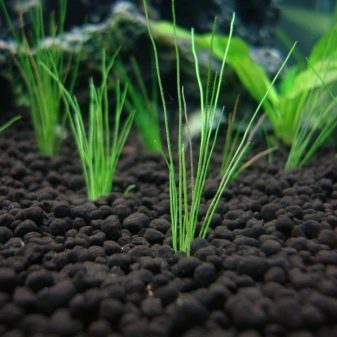

Why do you need a primer?
Few people thought about the fact that the empty bottom annoys the inhabitants of the aquarium. This is not a way to mask unsightly bottoms, but a powerful biological filter that is the basis for a green aquarium design. It is essential for maintaining the health of certain species of fish and living aquarium inhabitants. With its help, inside the tank, they create comfortable conditions for a certain type of ecosystem.
It is good as a means of mechanical filtration, it can change the water balance for the better, and is the key to the long life of aquarium inhabitants. Soil for aquarium plants creates a natural environment inside the tank and water. It participates in the nitrogen cycle, acting like a medium for bacterial colonization and growth. It is in it that a large number of microorganisms are colonized. It feeds living plants, facilitating their rooting, and in addition, masks and protects the laid fish eggs, so that they remain invisible to the eyes of adult inhabitants of the aquarium, who often eat such "food". The power of the plant root system depends on its type.
With the correct selection of its fraction and layer thickness, the beauty of the interior design will depend.

Primary requirements
The substrate purchased for the aquarium should help create as close to natural conditions inside the tank as possible. As the basis for the rooting of plants and the habitat for fish and other inhabitants of the aquarium, it must obey a number of requirements. Otherwise, beneficial bacteria will not be able to settle in it, which decompose the remains of food and fish excrement to mineral substances. The list of mandatory requirements for aquarium soil includes several rules.
- The surface of the substrate must be porous. Otherwise, beneficial bacteria will not be able to settle in it.
- The fraction of the material should not exceed 3-5 mm. Large particles of fish simply cannot move.
- The admixture of stones and foreign components is unacceptable, since the fish will not be able to get to the remnants of the food, as a result of which it will rot.
- Too fine sand that cakes must not be used for aquarium plants. This leads to the formation of methane and hydrogen sulfide.
- The substrate must be sufficiently rounded. Sharp components quickly coalesce, their corners injure the inhabitants of the reservoir.
- The fraction of the planting material should be uniform and uniform in size. An admixture of sand is fraught with stagnation, which is unacceptable.
- Lightweight substrate is not suitable for an aquarium. You need to choose a substrate from 3 types of filler: quartz, granite or basalt. All others are difficult to siphon, and in these plants they root and grow better.
- The substrate, having a buffering capacity, must be inert with respect to chemicals.
- The soil must have the right supply of nutrients vital for vegetation.
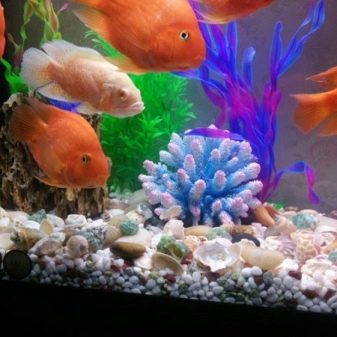
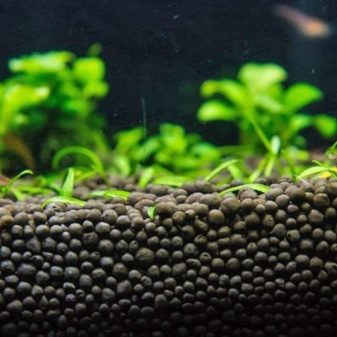
Varieties
All known varieties of aquarium substrate can be divided into 3 groups: natural, mechanical and artificial. Variants of the first type consist of materials of natural origin. These are crushed stone, quartz, pebbles and gravel. Such "soil" has no nutrients, and therefore plants begin to develop in it only after they accumulate waste, which will serve as a kind of fertilizer.
Mechanical substrate is extracted during mechanical or chemical processing of natural soil. Let's say this includes fired clay. An artificial version of the substrate is nothing more than a created mixed soil, enriched with nutrients and all microelements necessary for plant growth and development. This type of flooring is considered to be the best when the plant design is the main focus of the aquarium design.
Each type of flooring has its own nuances. For example, natural consists of what is at the bottom of rivers and freshwater bodies. In this case, individual stones can be coated with a special resin or enamel. If sea sand is used for it, then such soil cannot be used in aquariums, since it contains many living microorganisms that, when dying, will pollute the water. Artificial fillers are often made from plastic and tempered glass. The nutrient soil enhances plant growth and contributes to a change in the hydrochemical composition of the water.
It can be presented in the form of a ready-made substrate, or it can be made independently.
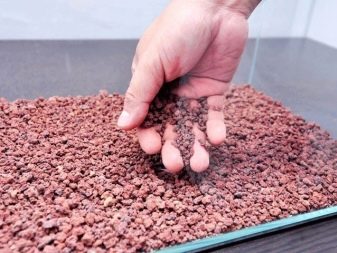

How to choose?
The best soil for plants is considered a nutritious substrate, it contains minerals and organic matter. However, it must be used in conjunction with the neutral one from which the substrate is created. Do not confuse aquarium soil with garden soil: these are completely different substrates, moreover, ordinary soil provokes decay of the aquatic environment.
If you plan to create a design in the spirit of an herbalist, it is better to purchase a ready-made substrate from a reputable company, enriched with nutrients. It will not reduce the hardness of the water in the tank, but it will encourage the development of more beneficial bacteria.If algae growth is too active, the aquarium soil can slow it down.
When it is not planned to grow a lot of greenery inside the reservoir, you can take a closer look at products with special dressings. They can be presented in tablet form, promote the growth of leaves, create a soil climate inside the tank. The composition of such dressings includes humic acids, which promote the absorption of nutrients by plants.
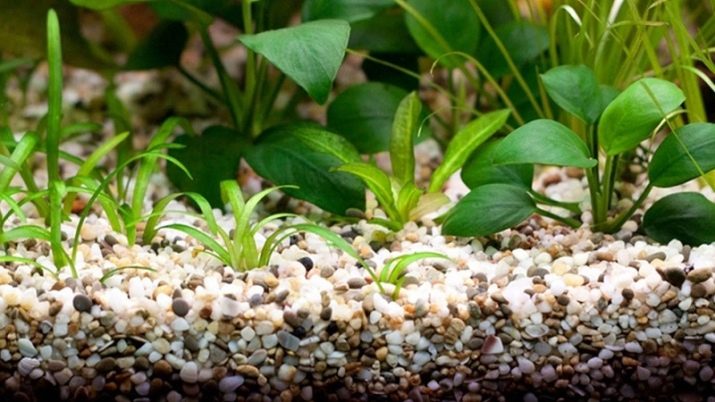
Particle shape, particle size and flooring color should be the primary factors in selection.
As for the color scheme, this criterion is rather aesthetic and practical. On a dark background, the inhabitants of the aquarium look brighter, while even the slightest contamination stands out on white or light ones. The size can be different, because you can use several types of material for styling.
Quartz sand, pebbles, coral chips can be used as flooring ingredients, having bought any of them in a specialized store. Both river and processed sea pebbles, as well as refined granite chips, are neutral types of substrates. When buying, you need to take into account the fact that the soil for aquarium design is by no means universal: it can be designed for a specific type of ecosystem, it is not suitable for every tank.
For example, it can target soil plants (Hemianthus, Eliocharis, Glossostigma), moss, or even large plants (Echinodorus, Cryptocoryne, say). The preference for soil in aquarium plants is different. Therefore, the fraction of the substrate is different, as well as its conditional solubility. Hissing options are not suitable for vegetation - they increase the hardness of the water. In neutral soil, a weakly acidic environment is formed, thanks to which the plants feed through the roots. Sintered clay is also a good option for aquarium soil.
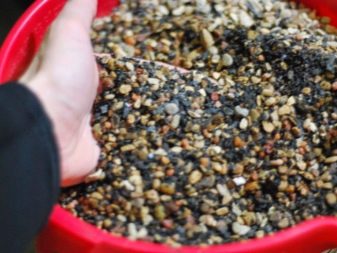
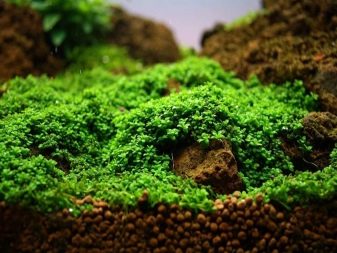
How to do it yourself?
DIY aquarium soil of the following components:
- activated carbon (granular or birch);
- clay and peat;
- sorbent as an active additive;
- chopped foliage or coconut fibers;
- coarse sand or fine pebbles.
A mixture of the above components is laid out on the bottom of the tank, while the thickness of the laid out layer should not exceed 2-3 cm. From above, the soil is covered with a layer of coarse sand or fine grained pebbles. Experienced aquarists choose the second option from two types of material, while the size of the pebble fraction does not exceed 3 mm. In fact, you get a soil consisting of two layers.
Its lower part is nutritious, and the upper one performs a protective function, preventing organic matter from being washed out soon. In order for the created aquarium soil to act as a biological filter, a bacterial activator can be included in it. It will perfectly contribute to stimulating the reproduction of a colony of denitrifying bacteria.



Subtleties of use
The primer must be prepared before use. For this purpose, it can be evaporated or fried. When evaporating, it is placed in a saucepan or bucket, poured with water and boiled for about 20-30 minutes. If the substrate is fried, then it is laid out on a baking sheet and sent to the oven for 30-40 minutes at a temperature of 180-200 degrees.
The design of the bottom of the aquarium is, in fact, a kind of layer cake, a combination of the substrate and the soil itself. In this case, the styling can be very different. For example, plants do not have to be located around the entire perimeter of the tank: they can grow in one of its corners... Other parts of the aquarium may contain driftwood and other decorative items. For this reason, the nutrient substrate is placed only where it is planned to grow the plants. For design purposes, professionals in aquarium design use partitions when dividing zones. The soil in the aquarium can be located not only evenly.It will look more interesting if you place it on a slide, hill, rise, for example, to the back wall of the aquarium.
Irregularities are good for creating a perspective effect, and such hills can be complemented by "paths" and "stones". At the same time, incorrect design will lead to design mistakes. For example, one of the common mistakes is lifting soil to the front wall of a tank. As for the tools that are used for aquascaping, it can be either a special set for shaping the soil, or standard bristle brushes for painting.
You will have to constantly monitor the condition of the soil, as well as prune the plants. In order to improve the aesthetic qualities of the landscape composition, an artificial colored one can be added to the nutrient soil. These can be glass stones of different shades, made in the form of drops.
Bluish translucent balls, harmless to fish and not changing the chemical composition of aquarium water, will look beautiful in tanks with fish.

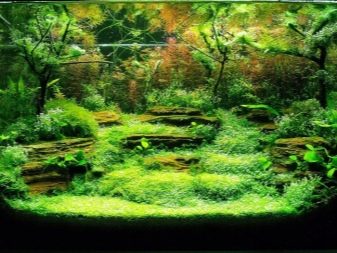
Possible problems
Unfortunately, over time, brown patches can develop in the plant aquarium. As it grows, it captures all parts of the plants and is the cause of their death. It appears when the aquarium liquid is contaminated due to an excess of ammonia in it and disrupts the photosynthesis reaction.
Also, one of the reasons for its appearance is the excessive content of organic matter in the soil used. To eliminate the problem, it is necessary to remove the soil from the aquarium and subject it to processing by calcining or boiling. Plants in this case must be replaced with new ones.
If the water becomes cloudy after starting, this indicates that the material was not prepared before being placed in the tank. In other words, it was not washed, and therefore dust and dirt particles began to rise upward, which led to cloudiness of the water.
Manufacturers often indicate on the packaging of the finished material that it does not need to be rinsed before being placed in the aquarium. but if tactile sensations indicate the presence of dust, it is necessary to immediately solve the problem by washing the soil under running water... If placed without preparation, a dusty "hurricane" will rise in the water. Even if in the future the dust settles to the bottom, with the movements of the fish, it will rise up again.

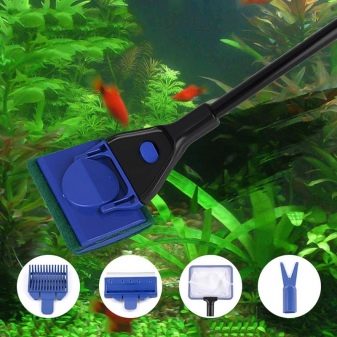
The soil is made by crushing stones, but manufacturers themselves do not always spend time washing it, although they say the opposite on the packaging. Someone, believing the manufacturer, when a problem is identified, tries to solve it by filtering, which takes 1-2 days. Others perform 2-3 substitutions, someone is saved by a synthetic winterizer.
It should be noted that flushing the soil for planting a herbalist is laborious... It takes a long time and is done until the substrate is completely clean. This takes more than an hour, and the aquarium soil is washed in a colander, making sure that clear water flows out of it. The pure product is poured into the aquarium, after which the plants are planted again, water is poured and the tank is left for a couple of weeks.
You cannot immediately populate fish in it, since the so-called bacterial outbreak will occur in the first days in the aquarium. This is a natural phenomenon, which is expressed in a slight cloudy water. It takes place in a couple of days, and at most - in a week.
After the bacteria stop multiplying, the water balance will be restored. Before that, you should not settle the fish in a new house: they simply will not survive in it.
For information on how to choose the right soil for aquarium plants, see the next video.








